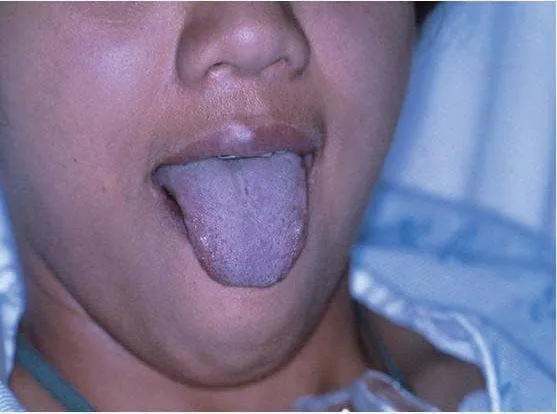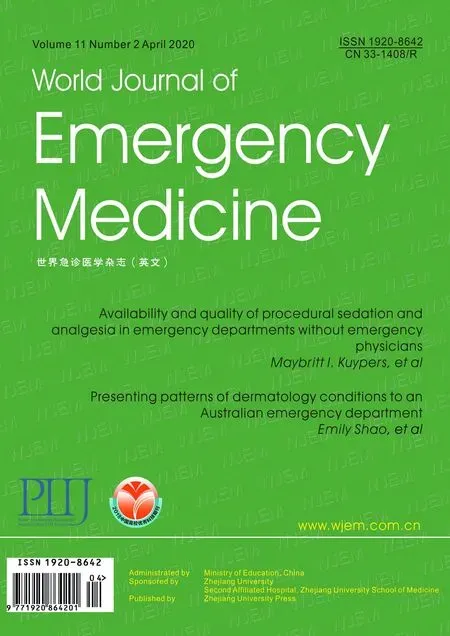A young lady presenting to the emergency department with blue lips: A case study with review of literature
Debkumar Chowdhury
Emergency Department, University Hospital Ayr, Scotland, UK
Dear editor,
A young lady in her early 20s presented acutely with shortness of breath with her oxygen saturations on room noted to be mid to 70% with normal respiratory rate, and blue discolouration of the lips (Figure 1).
The relevant past medical history and surgical history included well controlled asthma and a laparoscopic salpingectomy for ectopic pregnancy approximately 3 weeks previously. The only relevant recent history was use of cocaine over the preceding 48 hours.
On clinical examination there was evidence of a degree of respiratory distress with evidence of central chest discomfort present and evidence of discolouration of the lips to blue. The patient was also complained of fatigue, tiredness and a headache. There was noted to normal air entry on auscultation. On 20 litres of oxygen the maximum oxygen saturations achieved was 85%, and this raised clinical concerns in the patient.

Figure 1. Image of blue lips.[1]
The top differentials for the case was pulmonary embolism, pneumothorax, significant anaemia and evidence of poisoning. In the presence of normal air entry on auscultation, a significant sized pneumothorax was considered to be an unlikely diagnosis. A portable chest X-ray done in resus conf irmed this. With regards to a diagnosis of pulmonary embolism, for a patient to be profoundly hypoxic, it would signify a large embolus and haemodynamic instability would usually be associated with it. This however was not the case in this situation.
Whilst this was being arranged intravenous access was gained and a venous gas sample was obtained at the time to ascertain the acid base balance and a quick measure of partial pressure of carbon dioxide level.
The Methaemoglobinaemia (MetHb) level was noted at 34.2% range (0.4%–1.5%), the electrocardiogram showed a sinus tachycardia. A diagnosis of methaemoglobinaemia was made and appropriate treatment was instituted.
Between reading 2 and 3, the IV Methylene blue was administered, and reading 3 was done 20 minutes after administration of the drug. The results of the serial observations are as listed in Table 1.
Venous blood gas result (on 15 L oxygen): H+39.1,PCO25.26 kPa, PO23.92, HCO324.3, Lactate 1.46, SO267.8, CoHb 1.9%, MetHb 34.2%, Hb 11.95. Arterial blood gas result (on 20 L oxygen) at time of reading 3:H+34.2, PCO23.96 kPa, PO264.16, HCO320.9, lactate 0.97, SO299.8%, CoHb 0.7%, MetHb 4.5%, Hb 10.54.Serum blood test results: Hb 115 g/L (baseline 73), WCC 15.2×109/L, PLTs 396×109/L. Liver function tests were all normal. Electrocardiogram revealed sinus tachycardia.Chest X-ray showed no acute f indings noted.
Treatment
With the diagnosis of methaemoglobinaemia being made, our patient was treated with intravenous methylene blue at 2 mg/kg and was given over 5 minutes which resulted in prompt resolution of symptoms. The MetHb level was reduced from 34.2% to 4.5% on repeat investigations. She was given supplemental oxygen in the initial stages whilst covering and this was titrated to achieve oxygen saturations of 95% and above. She was subsequently admitted under the medical team for a period of observation overnight.
The treatment of methaemoglobinaemia with methylene blue is not without its risks. The side effect profile include hypertension, dizziness, nausea and vomiting and abdominal pain. A particular side effect of methylene blue is the risk of serotonin toxicity[2]leading to serotonin syndrome. Methylene blue is a monoamine oxidase inhibitor[3]and thereby at high doses can induce toxicity if combined with any serotonin reuptake inhibitor or selective serotonin reuptake inhibitor.
Another major side effect of methylene blue is anaemia especially in patients with haemolytic anaemia. On entering an erythrocyte methylene blue gets converted to leucomethylene blue which produces hydrogen peroxide and at high concentrations the erythrocyte gets broken down leading to haemolysis.[4]This was fortunately not the case in our patient as patient had normocytic anaemia from chronic disease and the dose used to treat was 1–2 mg/kg as opposed to the 5 mg/kg that precipitates toxicity as mentioned in the literature.
DISCUSSION
Methaemoglobinaemia can result from congenital or acquired causes. Congenital cause of methaemoglobinaemia is due to deficiency of enzyme diaphorase 1 (NADH- cytochrome b5 reductase), and this results in rise of methaemoglobin levels that leads to reduced oxygen carrying capacity of blood. The cause is due to presence of a recessive gene with one parent being affected causing the offspring having a blue coloured skin. Other causes of congenital causes include abnormal haemoglobin variants.
The acquired causes of methaemoglobinaemia are wide and varied. This ranges from use of local anaesthetic agents such as benzocaine, prilocaine and lidocaine to antibiotics such as sulphonamides. This results from oxidation of ferrous haemoglobin Fe2+to the ferric Fe3+state and this subsequently reduced the aff inity for oxygen and thereby reduces the oxygen carrying capacity of the blood. This also shifts the oxygen dissociation curve to the left hindering the release of oxygen to the tissue further compounding the hypoxia.
Typically, a level of MetHb of 34% is associated with dyspnoea, weakness and SpO2of approximately 85% which were present in our patient highlighted below is a table[5]correlating between MetHb% level and the possible symptoms (Table 2).
Cocaine and methaemoglobinaemia
Toxicity arising from the use of recreational drugs is commonplace in presentation to the emergency department. Methaemoglobinaemia associated with the recreational use of volatile nitrites has been well documented since the late 1970s[6]due to the oxidising nature of the nitrites. However, the methaemoglobinaemia associated with cocaine use is significant, cocaine itself doesn’t lead to the methaemoglobinaemia but rather due to the adulterations.[6]
There is a rise in the cases of cocaine use in the adult population, and in cases where benzocaine[7]is used to“cut” the cocaine, the incidence is high. Benzocaine is a cheap and widely found local anaesthetic agent that is strongly associated with methaemoglobinaemia. This is particularly prof itable as when in contact with the nasal passage has a local anaesthetic effect.
CONCLUSION
A high index of clinical suspicion is needed to detectthe possibility of methaemoglobinaemia and expedited treatment is required to ensure a favourable outcome.The clinician should also be aware of the possibility of this poisoning from the use of recreational drugs and the impurities that it may contain.

Table 1. Results of serial observations

Table 2. MetHb% level and signs and symptoms
ACKNOWLEDGEMENTS
The author would like to thank the patient for their kind permission in having their case discussed and form the basis of learning of clinicians.
Funding:None.
Ethical approval:Not needed.
Conf icts of interests:The authors declare that there is no conf lict of interest.
Contributors:DC wrote and approved the final version of the submitted manuscript.
 World journal of emergency medicine2020年2期
World journal of emergency medicine2020年2期
- World journal of emergency medicine的其它文章
- Information for Readers
- Food poisoning associated methemoglobinemia: Time to wake up
- Acute obstructive f brinous laryngotracheobronchitis induced by severe glyphosate surfactant intoxication:A case report
- Outcome predictors for severely brain-injured patients directly admitted or transferred from emergency departments to a trauma center
- An unexpected electrocardiogram sign of subacute left ventricular free wall rupture: Its early awareness may be lifesaving
- Effect of low high-density lipoprotein levels on mortality of septic patients: A systematic review and meta-analysis of cohort studies
